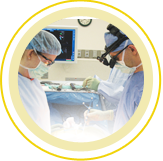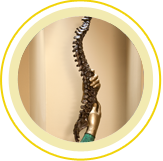Joyce Cantrell: Adult Scoliosis and Degenerative Disc Disease
Max W. Cohen, MD, FAAOS, who corrected Joyce Cantrell’s curvature in spinal fusion surgery, notes that adult scoliosis is most common in women – and difficult for many surgeons to treat.
“Most doctors won’t even attempt to tackle a case like this – scoliosis in an adult, an older adult,” Dr. Cohen says. “If the surgeons do something, they often sort of ignore the scoliosis and treat it like a degenerative disc.”
“That is because the great majority of neurosurgeons and orthopedic surgeons were trained to treat only degenerative conditions of the spine,” he says.
“That’s one category of spine surgery,” Dr. Cohen says. “The other category is deformity surgery. That’s where there is some sort of twist of the spine or some sort of curvature. That’s a whole other realm.”
“In a case like Joyce’s, where there’s a deformity – adult scoliosis, or curvature of the spine – in addition to degenerative disc disease, it’s critical to treat both conditions.” Dr. Cohen says. “Many surgeons do not do that.”
“Since very few surgeons have training in deformity surgery, they only see and treat the degenerative problem,” Dr. Cohen Says. “But when you have a degenerative problem superimposed into a scoliosis, ignoring the scoliosis often leads to early failure of the surgery – or it just doesn’t work.”
Dr. Cohen is the only doctor in the Triad with double fellowship training in both types of surgery. He completed a fellowship in spine and scoliosis surgery at Cornell University’s prestigious Hospital for Special Surgery, the top-ranked orthopaedics hospital in the U.S.
The approach to surgery at Spine & Scoliosis Specialists reflects Dr. Cohen’s dual training.
“What we do differently here is we look at the spinal alignment, not just each individual segment, but the whole global alignment and how it affects the patient,” says Dr. Cohen. “When the patient has a disc problem along with scoliosis (an abnormal sideways curvature) or kyphosis (rounding of the back), we feel that you need to address the entire spine – correcting the abnormal alignment in addition to the degenerative disc problem.”
To help Joyce with her scoliosis and degenerative disc disease, Dr. Cohen used instrumentation to fuse her spine from T4 to L4. Because her spinal column had become stiff, Dr. Cohen also performed osteotomies to loosen it up so additional straightening could be obtained.
“And she did very well with that,” he says. “That addressed her scoliosis and the arthritis that had developed within the scoliosis, and it helped her pain.”
Within a couple of years of the surgery, she developed disc degeneration lower on the spine – and had a second surgery for that.
“I was trying originally to save two discs, but with time she had worn those two discs out,” Dr. Cohen says. “So ultimately, we had to extend the fusion down two more. Using innovative techniques, we were able to remove the bottom of the scoliosis surgery and then extend the surgery down across the last two discs in the same kind of fusion we used before. That seems to have been very helpful for her and now she is doing very well.”
He notes that one reason many surgeons don’t perform adult scoliosis surgery is because it is complex surgery that can be especially time-consuming in older patients, with the risk of complications.
“This is surgery that you need to be able to do quickly but precisely,” he says. “We use muscle sparing and minimally invasive techniques wherever we can to minimize surgery time and to improve the recovery. We do so many of these surgeries and have become so adept at it, that we can do them in older adults with successful outcomes and without complications.”



